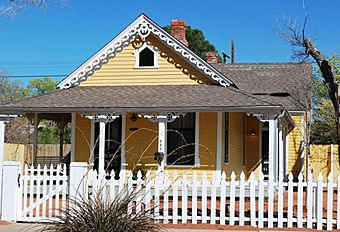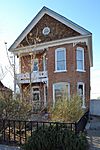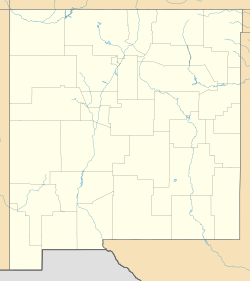Huning Highlands Historic District facts for kids
|
Huning Highlands Historic District
|
|

The Seth House
|
|
| Location | Huning Highlands, Albuquerque, New Mexico |
|---|---|
| NRHP reference No. | 78001804 |
Quick facts for kids Significant dates |
|
| Added to NRHP | November 17, 1978 |
The Huning Highlands Historic District is a special area in Albuquerque, New Mexico. It covers the whole Huning Highlands neighborhood. This district is known for its many old houses built in the Victorian style and other styles from the early 1900s.
The area is about 0.3 square miles (0.78 km²) in size. It is bordered by Dr. Martin Luther King Jr. Avenue to the north, Locust Street to the east, Iron Avenue to the south, and the Burlington Northern Santa Fe train tracks to the west. Huning Highlands was the first neighborhood built outside of Albuquerque's original town. Most of its buildings went up between the 1880s and the 1920s. This district was added to the New Mexico State Register of Cultural Properties in 1976 and the National Register of Historic Places in 1978.
Contents
History of Huning Highlands
When the Atchison, Topeka, and Santa Fe Railway arrived in Albuquerque in 1880, it brought a lot of excitement. People wanted to buy land and make money. Local business owners like Franz Huning, Elias S. Stover, and William Hazeldine formed a group called the New Mexico Town Company. They helped bring the railroad's main buildings to a spot about 1.5 miles (2.4 km) from the old community of Old Town.
This new area quickly grew into a busy place called New Town, which is now Downtown. Franz Huning also owned land on the sandy hills to the east. This area was called the Highlands because it was higher up. In 1880, this land was planned out as the first new neighborhood to be added to the town. It was named Huning's Highland Addition, which later became Huning Highlands.
How the Neighborhood Was Planned
A civil engineer named Walter G. Marmon designed the neighborhood. He named the main north-south streets after his own children, Walter and Edith. He named another street Arno, after Franz Huning's son. He also named a street Broadway, saying "every town should have a Broadway." The street at the very top of the gentle slope was called High Street.
Huning Highlands quickly became a very popular place to live in Albuquerque. Many important early residents of the city lived there. Unlike older Hispanic neighborhoods like Old Town, Barelas, and Atrisco, Huning Highlands was mostly built by people who had recently moved from other parts of the United States or from Europe.
Building Styles and Materials
Because of this, the houses in Huning Highlands looked different from traditional local homes. They showed styles popular in the eastern and Midwestern United States. These included Queen Anne, Italianate, and other Victorian styles. Many houses used parts that were made somewhere else and then put together. This created a mix-and-match look, though some houses followed one style more closely.
The neighborhood continued to grow between the 1880s and the 1920s. By then, almost all the land had been built on. Residents enjoyed places like Highland Park, which is one of the city's oldest public parks. They also had the Old Main Library and an electric streetcar line that started in 1911.
Changes Over Time
As Albuquerque grew, many wealthy residents moved away from the older inner-city neighborhoods. They preferred newer, more suburban areas further east. By the 1970s, Huning Highlands had become a poorer neighborhood. Many of the houses were rented out and not always well-maintained.
To help protect the neighborhood, the Huning Highlands Historic District was added to the National Register of Historic Places in 1978. In 1980, the Albuquerque City Council created the city's first Historic Overlay Zone for the area. This special rule means that any changes to the important historic houses need approval from a special commission. It also offers tax benefits for people who restore their homes.
These actions really helped the neighborhood. Many historic houses were restored. A local group reported that the number of properties considered "blighted" (meaning run-down) dropped a lot. It went from 52% in 1976 to 17% in 1986, and by 2005, it was estimated to be less than 5%.
Notable Buildings in Huning Highlands
Many interesting and historic buildings are found in the Huning Highlands Historic District. Here are some of them:
| Name | Image | Location | Year built | Style | Notes |
|---|---|---|---|---|---|
| AT&SF Memorial Hospital |  |
806 Central Ave. SE 35°4′57″N 106°38′17″W / 35.08250°N 106.63806°W |
1926 | Mediterranean Revival | An important Albuquerque landmark. |
| E. J. Alger House |  |
124 Walter St. SE | 1900 | Italianate | |
| Auge Store |  |
214 Arno St. NE | c. 1908 | ||
| D. A. Bittner House |  |
120 Walter St. SE | 1901 | Dutch Colonial Revival | |
| Boatright House |  |
220 Edith Blvd. SE | 1888 | Queen Anne | David Boatright was an early mayor of Albuquerque. |
| Charles E. Boldt House |  |
323 Edith Blvd. SE | c. 1904 | Dutch Colonial Revival | |
| D. R. Boyd House |  |
123 High St. SE | c. 1895 | Queen Anne | |
| G. E. Brewer House |  |
215 Walter St. SE | 1901 | Queen Anne | |
| T. I. Butts House |  |
201 High St. NE | c. 1909 | Queen Anne | |
| Children's Home and Hospital (Regina Hall) |  |
806 Dr. Martin Luther King Jr. Ave. NE |
c. 1921 | Prairie School | |
| H. G. Coors House |  |
116 Walter St. SE | c. 1920 | Bungalow | |
| P. G. Cornish House |  |
123 Walter St. SE | c. 1900 | Queen Anne | |
| Edward Buxton Cristy House |  |
201 Walter St. SE | 1897 | Queen Anne | E. B. Cristy was an architect and designed this house himself. |
| Duplex at 108-110 Arno SE |  |
108-110 Arno St. SE | c. 1898 | Folk Victorian | |
| J. L. Durling House |  |
410 Edith Blvd. SE | c. 1894 | Stick | |
| Andrew Hatch House |  |
218 Walter St. SE | 1901 | Folk Victorian | |
| Highland Hotel |  |
202 Central Ave. SE 35°5′1″N 106°38′44″W / 35.08361°N 106.64556°W |
1906 | Chicago School | An important Albuquerque landmark. |
| Mrs. Hill's Boarding House |  |
321 Walter St. SE | c. 1890 | Queen Anne | |
| Horner House |  |
520 Arno St. SE | 1881 | This is the oldest known house in the district. | |
| House at 204 Arno SE |  |
204 Arno St. NE | c. 1882 | ||
| House at 210 High SE |  |
210 High St. SE | c. 1895 | Folk Victorian | |
| House at 212 High SE |  |
212 High St. SE | c. 1890 | Queen Anne | |
| House at 306 Walter SE |  |
306 Walter St. SE | 1907 | Queen Anne | |
| House at 317 Walter SE |  |
317 Walter St. SE | c. 1890 | Folk Victorian | |
| House at 320 Edith SE |  |
320 Edith Blvd. SE | c. 1903 | Folk Victorian | |
| House at 411 Arno St. SE |  |
320 Edith Blvd. SE | c. 1890s | Queen Anne | |
| Jack Korber House |  |
301 Arno St. SE | 1916 | Prairie School | |
| J. E. Learnard House |  |
210 Walter St. SE | 1898 | Queen Anne | |
| W. J. Marsh House |  |
301 Edith Blvd. SE | c. 1895 | Folk Victorian | |
| C. L. McClanahan House |  |
201 Arno St. SE | 1910 | Queen Anne | |
| A. B. McMillan House |  |
119 Walter St. SE | 1896 | Queen Anne | |
| McQuade House |  |
201 Walter St. NE | 1901 | Queen Anne | |
| I. J. Mize House |  |
316 Walter St. SE | c. 1900 | Folk Victorian | |
| Old Albuquerque High School |  |
Central and Broadway NE 35°5′3″N 106°38′38″W / 35.08417°N 106.64389°W |
1914 | Collegiate Gothic | Listed on the State Register in 1977. An important Albuquerque landmark. |
| Old Main Library |  |
423 Central Ave. NE 35°5′2″N 106°38′33″W / 35.08389°N 106.64250°W |
1925 | Pueblo Revival | Listed on the State Register in 1975. An important Albuquerque landmark. |
| F. J. Patchin House |  |
207 High St. NE | 1906 | Dutch Colonial Revival | |
| Seth House |  |
322 Arno St. SE | c. 1883 | Folk Victorian | |
| C. E. Vaughn House |  |
423 Arno St. SE | c. 1900 | Queen Anne | |
| William Whitney House |  |
302 Walter St. SE | 1907 | Neoclassical | |
| Whittlesey House |  |
201 Highland Park Cir. SE 35°4′54″N 106°38′21″W / 35.08167°N 106.63917°W |
1903 | Norwegian Vernacular | Listed on the State Register in 1975. An important Albuquerque landmark. |



